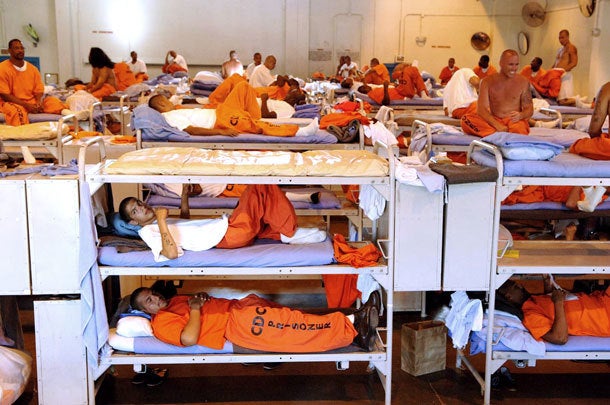
AP/California Department of Corrections
The American Mentality: Ideas of Crime and Punishment
While the mentality of the criminal justice system is power, control, and expansion, the mentality of the American public can be described in one phrase: “lock-em-up.” However, this view is more a reflection of manipulation by politicians and criminal justice officials, shaping the popular imagination, than what people actually favor once they learn about the realities of crime and punishment. Our ideas about crime and punishment are further distorted by the media with a preoccupation on violent crimes, with myths of crime being propagated in television programs like Cops and America’s Most Wanted, playing a significant role in shaping public perceptions about the nature of crime. As such, some policymakers seek to rationalize their punitive laws by arguing that they are simply responding to the public’s fear of crime, a position that is not always supported by public opinion surveys. Indeed, even though the media portrays the notion that we are facing a crime-wave, most citizens report that they “feel safe” in their communities and still view rehabilitation as a primary objective of corrections, preferring community-based sanctions instead of prison for offenders who do not represent a serious threat to public safety, when informed of the actual nature of crime and punishment.
While the mentality of society is somewhat ambivalent, one thing we can be certain of is the fact that Americans’ perceptions toward ethnic minorities and their roles in society have changed in ways that are detrimental to the entire community. In the context of the criminal justice system, we have been experiencing a shift from what some researchers call “the old penology, which emphasized individual responsibility, diagnosis, and treatment, to a new penology concerned with the identification, classification, and management of dangerous groups”, or what Malcolm Feeley and Jonathan Simon refer to as “the actuarial considerations of aggregates,” with impoverished Caucasians and minorities being the main target of the criminal justice system. Historically being socially, emotionally, politically, and financially bankrupt, many young Latinas and Latinos are now further displaced in society, from a very young age. As they grow older, encounters with the juvenile and criminal justice systems tend to push them even sooner and faster into the periphery of society. Then, already in the margins of society, ethnic minorities are being further attack by the latest series of events occurring in the last several years, events which are changing the perception of Americans, particularly policymakers, law enforcement officials, and court officials, as to how ethnic offenders should be treated by the criminal justice system, and, by extension, changing reporting practices, Latina/o portrayal in the media, our perceptions of crime and punishment, and the ways we respond to ethnic deviance and criminal behavior.
The New Logic of the Criminal Justice System
To place the American prison system in a global context, the United States not only has the largest prison population and the highest rate of imprisonment in the world, but the gap in relation to other countries continues to widen sharply. As noted earlier, by the end of 2005, one in every 32 adults was in prison, jail, on probation or parole, with more than 7 million people being under the control of the criminal justice system, with nearly 2.2 million (approximately 1 in every 136 US residents) being in jail or prison. China, with a population of approximately 1 billion people, ranks second with 1.5 million prisoners, followed by Russia with 870,000 prisoners, indicating a significant gap. Crucially, the US has 10 times the population of its northern neighbor, Canada, yet about 35 times the prison population (Bureau of Justice Statistics). Similarly, the US has the highest imprisonment rate, with 737 per 100,000 people, followed by Russia with 611 and St. Kitts and Nevis with 547. According to Ethan Nadelmann of the Drug Policy Alliance, the US has approximately 5% (300 million in 2006) of the world’s population (over 6.87 billion in 2006), but about 25% of the world’s incarcerated population.
Logically, to truthfully justify the passage of various criminal laws, which have made the United States the country with the highest prison rates in the developed world, a focal question must be answered: have crime rates increased significantly in modern times? From a race and ethnicity standpoint: is the American society experiencing a shift in ethnic criminality? That is, are more Latinas and Latinos committing crime? Are Latinas and Latinos committing more crimes? Are ethnic minorities committing different types of crimes? Or, is the current imprisonment binge simply a change in criminal laws, law enforcement practices, judicial process, or crime reporting practices? In truth, even though crime statistics are influenced by law enforcement tactics, court response to ethnic criminality, and reporting practices, crimes rates have stayed relatively constant, clearly indicating that ethnic minorities are not getting worse, but that the criminal justice system is becoming more punitive on minorities, especially for drug related offenses. In fact, today, the most frequent encounter with the police and the courts seems to be drug-related: distribution, possession, or usage.
An honest analysis reveals that ethnic minorities are not necessarily imprisoned at much higher rates simply because they are more prone than whites to commit crime. In effect, Latinas and Latinos are generally less likely to be involved in violent crime “than their non-Hispanic counterparts”. Of Latinas and Latinos who are sent to prison, the overwhelming majority are convicted for relatively minor, nonviolent offenses, or they are first-time offenders, with Latinas/os being more likely than whites to be arrested and charged for drug related offenses even though they are not more likely than other groups to use illegal drugs, and they are actually less likely to use alcohol. As cited by Professor José Luis Morín of John Jay College of Criminal Justice, “Contrary to conventional perceptions, Latinas/os have not been shown to be any more inclined to engage in illegal drug activity than Whites.”
With crime rates staying relatively constant, while imprisonment rates continue to increase, the ultimate question becomes: do American criminal laws actually make a significant difference in reducing crime? The answer to this question, as documented by Michael Lynch in Big Prisons, Big Dreams: Crime and the Failure of America’s Penal System, we can look at a testable hypothesis stating that as prisons get bigger and more people are incarcerated, crime should decline in society, by definition. Realistically, the fact that incarceration has expanded each and every year from 1973 through the present has not led to a steady downward crime trend, as reported by Rick Ruddell in America Behind Bars: Trends in Imprisonment, 1950 to 2000. Instead, criminal laws have resulted in the warehousing of thousands of people, with the majority of prisoners being impoverished whites, racial and ethnic minorities, and uneducated people. In short, “the modern logic of the U.S. correctional system can be summed in one word: imprisonment,” though, “the new logic becomes a leading force in the very same problem we are trying to solve: crime”.
To be continued . . . this piece is part of a sequence of articles about, “Latinos In The U.S And The Road To Prison”.
For further reading and insights consult: Hispanics In The U.S. Criminal Justice System: The New American Demography
Sofía Espinoza Álvarez is an author, researcher, legist, and advocate. She is a law graduate and holds a Bachelor of Science degree in criminal justice. Álvarez has maintained an active professional career and an intense research and publication agenda, publishing various academic book chapters, journal articles, and books. Her books include, Immigration and the Law: Race, Citizenship, and Social Control (forthcoming); Ethnicity and Criminal Justice in the Era of Mass Incarceration: A Critical Reader on the Latino Experience (2017); and Latino Police Officers in the United States: An Examination of Emerging Trends and Issues (2015).
For more, connect with Sofía on Twitter, Facebook, Linkedin, Instagram, GoodReads, or visit SofiaAlva.com. Got a question? Email me at: info@sofiaalva.com
